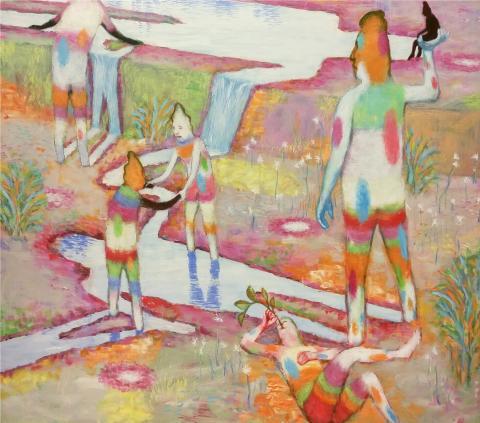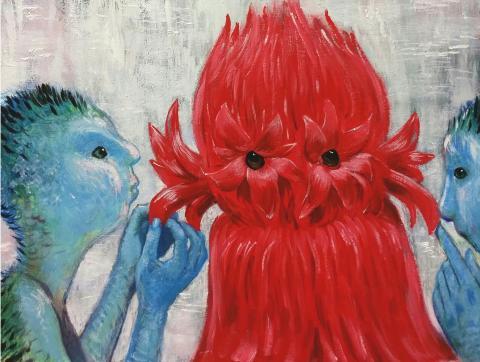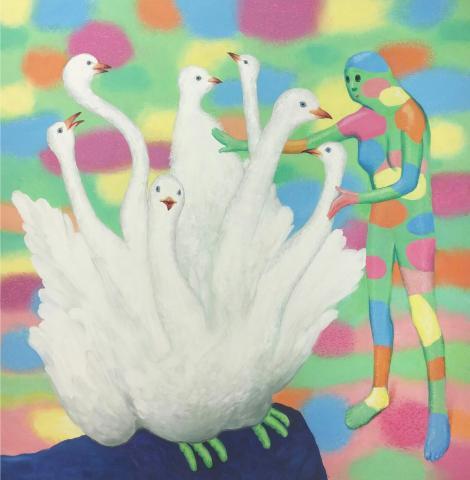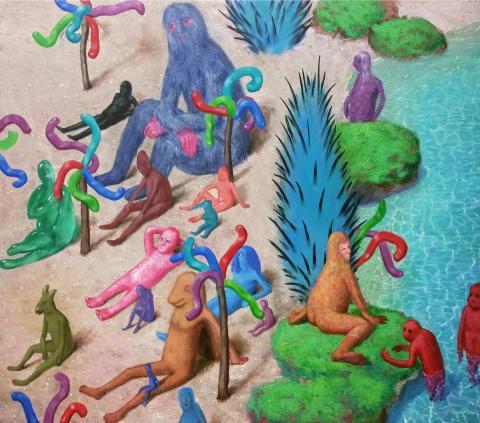DIPLOMA IN PAINTING AND PRINTMAKING, 1991
ALUMNI DISCOVERY INITIATIVE, INTERVIEW BY NATASHA JENSEN, 2015
WITH UPDATES ON MAY 22, 2019

Anthropondic (2018), acrylic on Masonite panel, 42 x 48"
Natasha Jensen: When did you graduate from ACAD?
Gary McMillan: I graduated in 1991 with a double major diploma in painting and printmaking.
JENSEN: Why did you decide on taking those majors at ACAD?
MCMILLAN: I first attended ACAD part time in printmaking as something fun to do. After a session, I decided that since I was taking a lot of courses and having fun doing it, I might as well go for a diploma. I tried the painting program and enjoyed it enough that I figured it would make a good major. I had already been painting on my own for years so it was a natural fit.
JENSEN: What was your time at ACAD like?
MCMILLAN: As an older student who was employed in a fairly solitary career, I found the experience highly stimulating and engaging. I was about ten years older than the average student and had a lot more artistic experience, so I occupied an interesting generational place somewhere between the other students and faculty. I socialized with my classmates but didn’t suffer from the same post high-school student anxieties.
As for the courses, I made a tremendous amount of work and pushed myself in many new directions. In the end though, I hadn’t quite gotten the idea of the post-modern contemporary artist and what would be necessary for a viable career as a contemporary artist. I should have spent more time creating relationships with my instructors.
JENSEN: What insights did your years at ACAD give you when looking at things? Why does what you learned at ACAD matter?
MCMILLAN: Art school trained me to have critical insight into the means and motivations surrounding art-making. I learned what art can look like and how it can be evaluated. Most importantly, I experienced the gratification of kicking aside self imposed constraints and just making something to see what it would look like. I learned to pull out all the stops when necessary, and to make work primarily for my own satisfaction. My audience would come second. All of this still applies today.

Floralismic (2018), acrylic on Masonite panel, 14 x 18.5"
JENSEN: A lot of graduates use the ACAD degree as a creative stepping stone. How did your education at ACAD direct your career?
MCMILLAN: I think my time at ACAD has only had an indirect affect. I never used my diploma on a job application or as a stage in pursuing further post-secondary training. I see it more as a bridge for connecting with the art community as a shared experience. I meet students and instructors from ACAD all of the time and my time there gives me some common ground. Being a practicing artist means being part of this community and professional success is absolutely dependent on participation. I’ve observed this trait in all of the successful artists I have met.
JENSEN: What’s your current employment?
MCMILLAN: For thirty years I have been a professional wax model maker in the jewelry industry, supplying custom design models for independent retail stores. Once a year I run a one day workshop at ACAD in the jewelry department. I am also an exhibiting painter and make periodic sales of paintings.
JENSEN: How has your art practice evolved since graduation?
MCMILLAN: My jewelry and painting careers have had their ebbs and flows over the years. I did a lot of landscape painting and exhibiting in the 1990’s, meanwhile maintaining a jewelry design business. In the 2000’s up until the recession of 2008 the jewelry dominated and I did very little painting. In 2009 I returned to painting and exhibiting seriously and I continue to do so. I now maintain the jewelry as a craftsman job for about two thirds of my time. The jewelry work is not very creative, but I am always trying to make better and more interesting paintings.
JENSEN: After graduation, what obstacles did you encounter and how did you overcome them?
MCMILLAN: I had continued my jewelry work through school so I had no employment obstacles upon graduation. I even had an easy time showing landscape paintings in a gallery and did fairly well. When I started painting again in 2009 and began to build up a body of work which by 2011 seemed to be viable as contemporary painting, I began looking for showing venues. Here’s where I hit a bit of a wall. I didn’t know anybody in the art scene. I also had to figure out how to write up artist proposals, photograph and photo-edit my work, and do it all digitally. At the time I had no typing or computer skills.
I remember being told about all of this at ACAD and now was the time to apply myself - which I did. I slowly solved the technical issues of proposals. ACAD had given me lots of practice in writing so at least I had a head start on that. The most trying part was going to art shows at the galleries which seemed most relevant to me. I made it my purpose to meet the most influential and connected people. I made a point of getting to know gallery owners and the exhibiting artists. I am a fairly introverted person and this was all very difficult. It still can be, as I occasionally find myself having to push myself forward with a smile .
JENSEN: What are the benefits you’ve found to pursuing an education in the arts?
MCMILLAN: I got to meet a lot of people who like to make imaginative things. While at ACAD, I had a great time doing the same and could take advantage of all of the physical space and equipment that I don’t personally have. Art school was a place for creative freedom tempered with critical analysis. It is this intangible pairing of invention and educated judgment that I value most from art school.

Galapagos (2018), acrylic on Masonite panel, 48 x 48"
JENSEN: What would you like to be recognized for? Where does art fit into your future?
MCMILLAN: I would say the opportunities for community are there in art school, but the students must recognize them and reach for them on their own. Every student is looking for something different. Looking back, I would say I made only a partial use of the school’s resources. I didn’t connect with colleagues and senior artists as much as I could have. I should have sought out a mentor of some kind. Maybe I just wasn’t prepared to commit my life to art in a way that would warrant - what seemed to me - a huge amount of social effort. I wouldn’t want to have gotten everyone’s hopes up, just to only drop out of the scene.
Remember, art school can be an intense and confusing place in that it churns up a lot of difficult self-reflection. It all makes sense now about how to integrate into an arts community, and for me my current timing is just right.
Professionally, I would like to be recognized for having made work of significant value to the artistic culture of the country. To be more egotistically honest, I would like to see my acclaim extend to let’s say…. New York, London and Berlin. That would be nice. To stay in the game, I have heard that artists need to have hugely inflated fantasy egos, so there you go!
I will continue to make paintings or whatever else seems equally interesting. I will keep looking at and talking about great art, I will continue to puzzle over the difference between good art and bad art and will try to avoid making bad art. I will always feel pleasure in meeting artists whose work I admire and derive even more pleasure if I think the feeling is mutual.
JENSEN: How could you imagine ACAD supporting our alumni?
MCMILLAN: I don’t really know. I’m not a big institutional thinker. I suppose a continuing effort to exhibit and celebrate the work of alumni is a good idea. This program I am writing all of this for is gratifying to me. It is nice to be noticed. Usually it is only the go-getter creative workers who get noticed. It is a competitive world and artists don’t do themselves a favor by working quietly in their studios. If ACAD isn’t already doing so, bring in some almost-successful alumni who aren’t shy about telling students about how they are trying to make it out there in their visual arts related field. Then bring in some hot-shots who have made it to hammer the points home. Present it like a talk show. Make these presentations mandatory for students. This would be good for both the alumni and students.

Hominospeciation (2018), acrylic on Masonite panel, 42 x 48"
JENSEN: What do you feel is the role of ACAD and our alumni in shaping our cultural and economic prosperity?
MCMILLAN: You got me on that one. I could debate a bunch of platitudes or quote from socioeconomic reports. Here is what I think: A society without some kind of artistic expression doesn’t exist. I’m sure even North Korea has art even if it is no more than devising fetchingly new ways to arrange missile launch vehicles. Though not really necessary in the cultivation of such basic artistic endeavor as I just cited, art schools are necessary in the development of the newest and most interesting art. Though they are often short on teaching the technical aspects of making art, art schools are very good at liberating the imagination and then sharpening it.
Thus, while Canada or anywhere else for that matter will always have some kind of art, the most inventive and forward looking people — namely the kinds of people that drive a society forward — will always want to experience the most inventive and interesting art. Sure it is an elitist thing, but it’s that head-scratching originality that helps put a place on the map culturally and, by virtue of that, economically. By fostering engaging originality, ACAD helps put Calgary — and by extension, Canada — on the map.